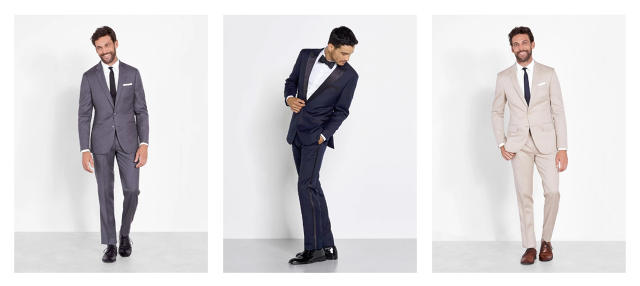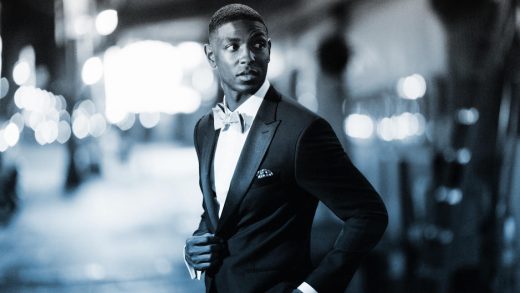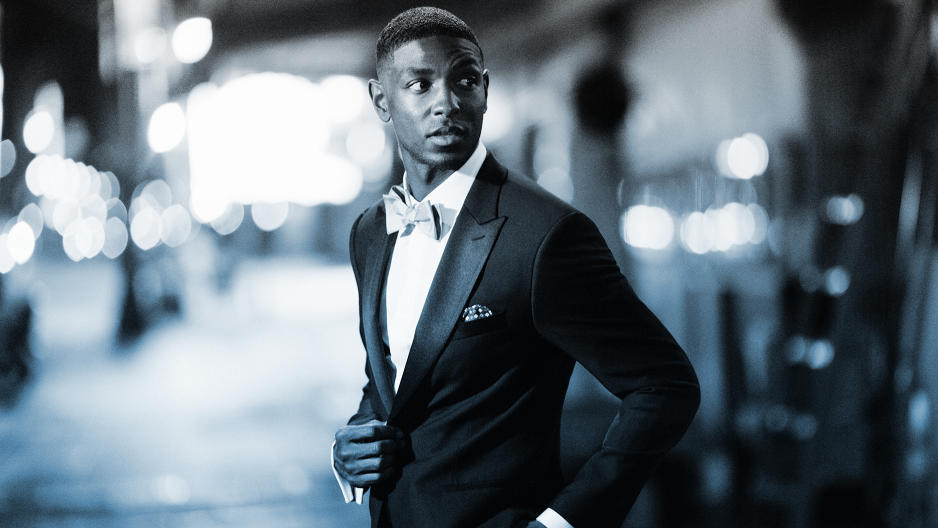The Secret To A Perfectly Tailored Suit? For The Black Tux, It’s Machine Learning
When Andrew Blackmon and Patrick Coyne launched The Black Tux in 2013, they did so with the intent of helping men suit up without setting foot in a Men’s Wearhouse. The goal was to upgrade suit and tuxedo rentals by introducing higher quality garments and placing an emphasis on fit, qualities that Blackmon says the market was severely—and surprisingly—lacking. The Black Tux promised to do all this as an online retailer, which meant men could rent formalwear with a few clicks. The company charges about $95-$145 for suit and tuxedo rentals, depending on the design, while rentals of complete outfits—which include additional items like a dress shirt, leather shoes, cuff links, and a tie or bowtie—run between $150-$215.
Recently, The Black Tux unveiled a new and improved fit algorithm that claims to accurately predict how a suit should be tailored, based solely on the measurements customers provide online. The secret sauce: machine learning, built on a robust data set accrued over the past few years. As Black Tux feeds the algorithm more data on how customers’ measurements have historically correlated with suit sizes and alterations, it gets better at predicting which cuts will work best for future customers.
I spoke to Blackmon about The Black Tux’s unique approach to fit and garment quality, how human intuition factors into the fitting process, and why the company appeals to men looking for a little more flair.
Black Tux isn’t the only company catering to men searching for affordable, well-designed tuxedos. What sets Black Tux apart from the likes of Generation Tux or Combatant Gentlemen?
Andrew Blackmon: A few major things separate us from them. Number one is quality of garments and supply chain. The majority of rental garments in the U.S. are made from one or two manufacturers. When my cofounder and I set out to start this business, one of the things we were sort of upset with was the actual garment, which felt more like your dad’s old suit than something you wanted to get married in or go to prom in.
When we researched, we realized that the manufacturers making all the rental suits in the U.S. are also making uniforms—so they’re making really thick, stiff [suits that] feel almost like cardboard sometimes. We decided we needed to disrupt the supply chain, and make something that is closer to what you would buy in high-end retail stores for $1,000 than what you would see on somebody in a hotel uniform. So we source all of our wool from Italy, from one of the best wool manufacturers. We’ve developed our own wool with them, and then we send our suits to some of the finest suit makers in the world that are making suits for brands like Ralph Lauren and Burberry.

The second way is leveraging e-commerce to give people a convenient experience. We stand behind our quality so much that we’ll allow our users to book a home try-on for free anytime before their event. We are the only rental company that sends the suits two weeks before a customer’s event. Most companies send it one week before. We feel like the customer wants a little bit more time with the garment. We’re also the only ones that have retail stores. Right now, we have two, and we’re opening a bunch more in 2017, for the customer or the bride or groom that really want the hands-on experience, to see the fabric before they rent.
Obviously a suit has a number of moving parts. How do you take the measurements that your customers enter online and accurately translate those into a jacket, pants, and shirt?
We have a machine learning algorithm that trains itself as we get more data and gets better over time. But when we first started the business, we basically built an algorithm in Excel. We used a bunch of data that we had sourced from the government, actually. The government had a large database of men who were measured for Army uniforms. It was really interesting: We were able to access this data and build our algorithm around that. But what that doesn’t take into account is that the army may not be representative of our customers, so over time, we’ve gotten a lot better at refining what we need to collect from users and how we can create this machine learning system.
The other thing I would add is that the way we look at data is not necessarily as an end-all. We like to have a personal touch. What the algorithm does for us is take the person’s height, weight, and body type in questions they answer—or a person’s self-submitted measurements and combines it with the height and weight—and then says, based on the measurements of our garments and our historical performance and fit, this is what this person is most likely to wear with X% confidence.
Sometimes for people that are in between sizes, we want to ship something that we’re 99% confident is going to fit. If the confidence is lower, we have a team of fit specialists that will eyeball it and then make calls to customers, in case that it looks like the customer submitted the wrong information, or the customer needed a little help with their own measurements. We like to use data not to just spit out something and say, ‘This is what this person is going to rent,’ but to allow us to make the best prediction on our end.

What happens when somebody gets their outfit, and they’re not happy with the fit? You’ve said most of your customers order their outfits at least a month an advance, but you also accept rush orders up to four days prior to a customer’s event. How do you figure out what the issue is without being there in person, and make sure they have an outfit that fits in time for their event?
This is also where our team of fit specialists will come in. The tuxedo is due to arrive two weeks before the person’s event, so we have enough time to get them something else. Less than 8% of garments actually don’t fit on the first try, so we have a pretty high accuracy rate. But when they don’t, the customer calls our fit specialist team. They can do a phone or a video consultation, where they’ll actually show the fit specialist, ‘Hey here’s what doesn’t fit, what do you recommend?’ The customer actually keeps everything that they originally had, and we just send them—for free—a replacement item, and then they send everything back together after their event. So it’s really convenient for the customer. Most of the time, it’s just, ‘My shirt neck is too small,’ or ‘My jacket sleeves are too long.’ The other option we have is if the customer is in a bind, and doesn’t have time to do this—say, the customer got their shipment 14 days before their event, but didn’t open the box until 12 or 13 days before—we’ll allow them to take it to a local tailor, and we’ll refund their bill.

It sounds like you adjust these garments pretty regularly to fit different body types. What does your inventory look like? Do your suits tend to have shorter lifespans?
We carry a very large bell curve of sizes. So where most rental outfits would probably just carry a 42 regular and a 42 long, we would carry a 42 extra short, short, long, extra long, extra-extra long. Our goal, actually, is that we wouldn’t need to tailor garments—that because we have so much variability in each size and such a sophisticated algorithm, we would be able to grab something off the rack and send it to the person. But of course there are certain body types that require tailoring, and we have to tailor, I think, somewhere between 5% to 10% of our garments before they go out. What happens is it goes out to the customer, comes back to us, and will be flagged in our system as “this garment was tailored.” And then we’ll reverse tailor it to what the size actually was. There are actually a lot of tailoring techniques that do not damage the garment—say, certain stitching machines that can still preserve the life of the garment and make adjustments. If you ever need to cut the fabric when you’re tailoring something, certainly that damages it, but we try not to do that.
One recent development is that some grooms have taken a page out of the bridal playbook and have started doing outfit changes between the wedding and reception. What are other changes you’ve noticed in terms of what grooms now want, and how are you trying to address them through Black Tux’s offerings?
We launched this company three and a half years ago. In that time, the awareness of grooms has greatly increased, and the desire of grooms to customize their wedding looks has increased. The tone is more, ‘Hey, here’s exactly what I want. I want to wear this for the ceremony and maybe this for the reception,” or, ‘I want to wear a peak lapel jacket with a diamond-shaped bowtie.’ They’re coming to us knowing what they want. What we’ve decided to do because of that is produce smaller runs of collections that will fit for these type of events. So we produce several different light dinner jackets—some with a white lapel, some with a black shawl collar. We’re never producing a huge amount of different styles, but we’re curating ones that we believe to be fashionable, and these are inspired by men’s shows that our designers are taking part in. So we’re basically just saying: Okay, we see that the guy has more discerning tastes right now. Let’s become the experts on formal wear and offer him things that he may not have known existed and things that he may be looking for that you can’t currently rent.
For a lot of brands, renting a suit is a pathway to buying the suit. Is a purchase option something you are considering?
I think you’re absolutely right: If you look at Men’s Wearhouse, their business is essentially built on their rental business. They have these rental customers and convert a pretty high percentage of them to buy something. We will experiment with that. We have very high demand; a lot of our customers call us and say, ‘Hey can I just keep this suit? This is a great suit—first time I’ve worn something that’s high quality, and I want to buy it from you.’ Right now, we don’t do it because we have a lot of demand for our rental service, and we need to get the suits back. But it is something that we’ve been thinking about.

So what do you think the future of suit buying will look like?
I think there will always be a market for rentals and sales. I think the market for rentals is expanding because people like us and others are offering a better experience, better quality, better assortment. If you own a tuxedo or suit, you’re going to wear that same thing to every event. Say you spend $1,000 on a suit. You wear that same one to 10 events—or you could spend, with us, $1,000 and wear 10 different suits to 10 different events. I think guys are more aware of that, and they really enjoy that ability.
Where I see the market going is definitely more online, but the reason we’re doing things like home try-on and stores is because for it to be completely online is not possible. I think this market will always be a hybrid of online and offline. A lot of people consider this a big purchase, and they want an experience with it—either via home try-on or via store—before they rent. We’re aware of that, and that’s why we’re opening our own retail locations.
This interview has been edited and condensed.
Fast Company , Read Full Story
(48)



